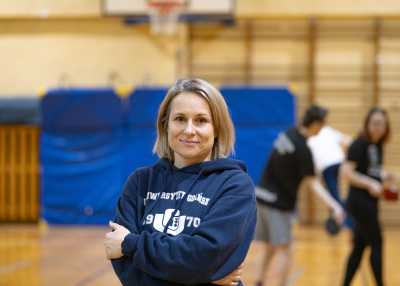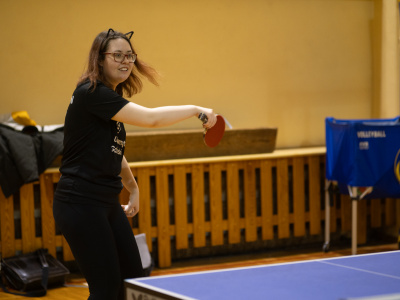Is it possible to prepare sports activities for everyone and - at the same time - for each individual? Mgr Małgorzata Aftańska from ASA UG, who runs the Sports Section for People with Disabilities (SON) at our university, had to find the answers to these questions. After more than three years of operation, the SON provides a space to play, train and expand boundaries. How did it come to be? We invite you to read the interview.
Marcel Jakubowski: - When did the Sports Section for People with Disabilities (SON) start?

Mgr Małgorzata Aftańska: - The impetus for the creation of the section was the ASA Integrative Polish Championships - a series of sports competitions for people with disabilities held since 2016. We started with the idea at the most difficult time for such initiatives, i.e. pandemic 2020. It was, therefore, not easy to find a student and invite them to physical activity, which was already severely limited during this period. We were incredibly lucky, however, because the Academic Sports Association offered us the opportunity to organise the ASA IMP in table tennis. As the ASA UG Academic Club, we took up this challenge, which ended in a huge organisational success and gave us the energy to continue.
- You mentioned that these students need to be found. Is it difficult to reach people with disabilities at the university?
- Due to Data Protection, it is not possible to access information about students with disabilities. We often manage to 'catch' these people during compulsory physical education classes, which is an excellent opportunity to pass on information about our section directly. But this applies to the student who is open to such activities. It is usually the case that people unfortunately do not want to make themselves known, even more so if the disability is not visible. Disability sports are still not very well publicised in the media, and I think this is also a significant limitation - especially mentally - in society as a whole. It's all about making physical activity accessible to everyone; this is exactly the case in our section. With us, you don't have to be an athlete. The premise of these classes is to integrate and activate people with disabilities. That is why we offer many disciplines so everyone can find something for themselves. The added value of SON is getting to know oneself in different situations, going out of one's comfort zone and exceeding one's limitations. This is evidenced by the medals won at the ASA IMP by our athletes from the SON ASA UG section.
- Just taking part in such activities is undoubtedly a big challenge. How are the SON athletes coping with it?
- It's a great field for everyone. People with disabilities have a certain mental stereotype when it comes to physical activity, especially if someone is struggling with a mobility impairment. It is important to realise that these things are possible, while they require complete individualisation. Every disability has its own path. I try to create a space where everyone can feel comfortable and make the most of their abilities. We are currently running three different training sessions. Firstly, sports games, namely boccia, goalball, and especially table tennis. Secondly, swimming, because it is considered to be the best rehabilitation. And thirdly, strength training, which is very individualised and versatile.
- Is it an accurate stereotype that the swimming pool is the best rehabilitation?
- It is so accepted that all postural defects, muscle tensions, and pains can be reduced in water. This is also a characteristic of SON participants that they associate movement with rehabilitation. They were usually dismissed from P.E., and any alternative to these classes was movement therapy. When I invite them to do physical activity together and explore new sports, they understand it as just another rehabilitation. So I had to disenchant the movement and do my best to present physical activity to them as a form of pleasure, development, and fun, but above all, an encounter with another human being
- Does the social aspect have a big motivating effect on the athletes?
- While everyone has a different disability, the athletes of SON ASA UG feel very comfortable with each other. They get to know each other; previously, many felt like they were the only ones with disabilities. They see various disabilities during activities, so they broaden their horizons. The very fact of belonging to a group has many benefits, including a sense of acceptance and mutual support. This contact with other people is much needed, and if they can include a sporting spirit that motivates them to set higher and higher goals, they can really achieve a lot during these activities.

- Does competition motivate them to exercise? Or are there other motives, like self-development or proving to myself that I can?
- This taste of victory is beautiful, and our athletes have learnt that. Justyna is a table tennis player who won the ASA Polish Championship in her category for the third time. For her, this is very motivating, and the prospect of losing her leading position is not too encouraging. However, not everyone has such predispositions and the character of a 'fighter'. When competing, everyone sets their own goal. For some, the motivation to train is the desire and opportunity to win medals; for others, it is to discover and improve their own capabilities. However, the greatest reward for sporting success and motivation to continue working is winning a medal, which allows receiving a sports scholarship at university.
- Are there any sports that people with disabilities could participate in but there is no equipment for them, for example? I myself am a fan of climbing competitions for people with disabilities.
- Currently, there are 12 sports in the Polish Integration Championships, with an average of 60 to 100 competitors in each. Every year, new disciplines are introduced to broaden the horizons. I haven't heard of climbing or wheelchair basketball, but competition in wheelchair fencing, sitting volleyball, or shooting has been organised. I think that nothing is impossible to arrange. The limitations are only in our heads, so if someone throws me such a challenge, I am happy to take it.
- How many people attend the Sports Section for People with Disabilities?
- The section has 12 members and 10 of them train systematically in preparation for competitions. Thanks to the wide range of activities, I think everyone finds their place here. One athlete is fixated solely on strength sports, another chooses only swimming, and others are practically at all three training sessions a week, as this has become their driving force in life (beware - sport is addictive!).
- Is there room for more participants in SON?
- Of course, there is! We are open all the time and are waiting for more athletes. All you need is a disability certificate and to be a student, doctoral student, or employee of UG. There are no qualifications or fitness tests. Also, don't worry if someone can't run or alternate circles. We will teach that.
- How would you encourage someone with a disability who has doubts to join the section?
- There is nothing to encourage here; you have to come, experience it for yourself, and feel the atmosphere. Until you get to know these people, this atmosphere, you don't know what you are missing. Showing up for one class doesn't commit you to anything. For our part, we provide the atmosphere, sport, and amusement - simply ASA.
